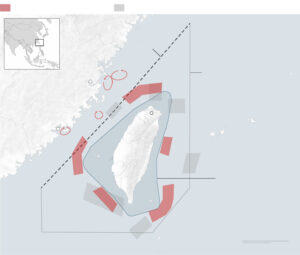Testing the Waters for Potential Power Seizure
China has recently intensified its military drills around Taiwan, purportedly to test its capabilities to “seize power” over the island. These exercises, conducted by the People’s Liberation Army (PLA), represent the largest in over a year and come at a politically sensitive time following the inauguration of Taiwan’s new president, Lai Ching-te. This article delves into the implications of these drills and the broader geopolitical context.

Background of the Military Drills
The PLA’s exercises began on Thursday, marking the onset of significant military activity around Taiwan. The drills involve a multifaceted approach, including warships, fighter jets, and for the first time, China’s Coast Guard. The operations span the Taiwan Strait, as well as the northern, southern, and eastern regions of the island.
Key Objectives of the Drills
According to the PLA, these drills are designed to test the ability to jointly seize power, launch coordinated attacks, and occupy strategic areas. This comprehensive military maneuver underscores China’s intention to showcase its readiness to respond to what it perceives as separatist activities in Taiwan.
Political Context and Responses
The timing of these drills is particularly noteworthy, coming just days after the inauguration of President Lai Ching-te. Lai, a proponent of Taiwan’s sovereignty, has been labeled a “dangerous separatist” by Beijing. His inaugural address, which called for an end to Chinese intimidation, has only heightened tensions.
Taiwan’s Defense Measures
In response, Taiwan’s Defense Ministry has condemned these exercises as “irrational provocations.” The ministry reported significant PLA activity, including the detection of numerous aircraft and warships near the Taiwan Strait. Taiwan has mobilized its own sea, air, and ground forces to counter these maneuvers.
Geopolitical Implications
China’s Communist Party views Taiwan as an integral part of its territory, despite having never governed the island. This belief underpins Beijing’s justification for potential forceful reunification. The drills serve as a stark reminder of this stance, particularly under the leadership of Xi Jinping, who has prioritized Taiwan’s “inevitable reunification” with mainland China.
Domestic Impact in Taiwan
Despite the heightened military activity, life in Taiwan continues with a semblance of normalcy. The island’s population has become accustomed to such threats, although the frequency and intensity have increased in recent years. This resilience is echoed in the sentiments of the Taiwanese public, who express confidence in their ability to defend their sovereignty.
Also Read : Taiwan Detects 30 Chinese Military aircraft Around Island: Ministry
Strategic and Tactical Analysis
The PLA’s exercises are not merely military posturing but serve strategic purposes. Experts suggest these drills are designed to practice blockading Taiwan, a critical aspect of any potential military campaign. By targeting key ports and cutting off energy imports, China aims to cripple Taiwan’s economy and military response capabilities.
Involvement of the Coast Guard
The inclusion of the Coast Guard in these drills represents a significant tactical evolution. This move indicates China’s intent to exert control over Taiwan’s outlying islands, enhancing its strategic positioning. The drills have covered areas around Kinmen, Matsu, Wuqiu, and Dongyin, all of which are critical for Taiwan’s defense operations.
International Reactions and Future Prospects
Internationally, these drills have drawn scrutiny and concern. The United States, while maintaining informal relations with Taiwan, continues to support the island’s defense capabilities. Analysts suggest that while an imminent invasion may not be on the horizon, the constant military pressure serves to blur the lines between peace and conflict, potentially laying the groundwork for future aggressive actions.
Political Messaging
The drills also serve a political purpose, signaling to both domestic and international audiences China’s resolve regarding Taiwan. The exercises are designed to influence Taiwan’s internal politics and its new administration, seeking to exploit and deepen existing divisions within the island.
Conclusion
China’s latest military drills around Taiwan are a complex display of power, serving both strategic and political objectives. As tensions continue to rise, the international community watches closely, aware that these maneuvers could signify broader intentions and potential future conflicts. For Taiwan, the challenge lies in navigating these provocations while maintaining its sovereignty and security.

